Forever associated with the WWII Wehrmacht, the stahlhelm (literally, ‘steel helmet’) enjoyed surprisingly long use in Latin America after WWII, up until the present time.

(Bolivian soldiers with stahlhelm M35 helmets and M16 assault rifles.)

(Chilean soldiers in 2009 wearing the stahlhelm M35.)

(Late 1950s Dominican Republic soldiers with stahlhelm M53 helmets, NATO-standard FN FAL assault rifles, and American M1936 belts from WWII Lend-Lease.)
Basics characteristics of the German stahlhelm
The stahlhelm family started during WWI with the M18. During the Wiemar era, a limited-production follow-on, the M33, was developed.

(stahlhelm M33)
The stahlhelm M33 design was not actually “stahl” (steel) but rather compressed material called Vulkanfiber. None the less, it kept development of the helmet’s shape and style current.
The design most people associate with the word is the stahlhelm M35, which entered service in the late 1930s and served Germany throughout WWII. It was made of high-molybdenum steel with a perforated leather suspension and leather chinstrap. It’s distinctive coal-scuttle shape offered excellent protection, and the overall design was comfortable and effective. Millions were produced.

(stahlhelm M35)
The remaining versions, the stahlhelms M40 and M42, were simply the M35 with features deleted to speed production and save steel as Germany’s situation deteriorated.

(stahlhelm M40)
Argentina
In the late 1930s, the Argentine army evaluated the stahlhelm. No order was placed with Germany however it was decided to produce a cheap domestic copy of the Wehrmacht’s stahlhelm M35, known as Casco M38. The Casco M38 was made of what was described a “fiberglass” but was actually a densely-compacted felt compound. This concept was similar to the Wiemar-era stahlhelm M33 which was made of Vulkanfiber. In size and shape the Casco M38 mimicked the Wehrmacht’s stahlhelm M35, however it was obviously lighter and had a different, Argentine-designed suspension.
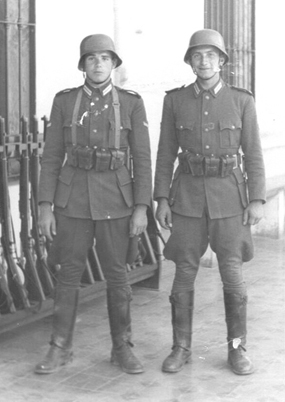
(The Casco M38 with some of the design’s first recipients in 1938.)
The Casco M38 was intended as an intermediate step for the 1930s Argentine army. Previously there was no standard-issue helmet at all; which is not surprising for an army of South America when one considers that more advanced militaries (France, Great Britain, the USA) did not make steel helmets general-issue until the 1915-1917 time frame. A previous small buy of Austro-Hungarian stahlhelms was a failure as they were hated by Argentine troops. At the time the Casco M38 was introduced, standard battle headwear in the Argentine army was cloth hats.
The Casco M38 never achieved full dominance in the Argentine army, as during the immediate pre-WWII era the country also imported Swiss M/18 and Italian M33 helmets, plus small experimental buys of other types. The Casco M38 was primarily used for exercises and parade use. As originally issued, the Casco M38 was green and had the Argentine national blue-white roundel on both sides.

(Argentine soldier with Casco M38 helmet and Walther P38 pistol in the early 1940s.)
During the late 1930s, Argentine public opinion was decidedly favorable towards the Third Reich and the Casco M38 was tremendously popular with Argentines, both civilian and military. It was widely featured in publicity photos, recruiting posters, etc and was almost certain to be seen in any public military parade or ceremony.

(Argentine soldiers with the Casco M38 in 1941, when the country was neutral. The Wehrmacht influences are quite apparent in not only the helmet but also the uniform designs.)
For almost all of WWII, Argentina remained neutral. The Casco M38 remained in widespread Argentine army use. On 27 March 1945, Juan Peron declared war on the Axis – but in deference to public opinion, which was at least still partially pro-German, it was phrased as “war against the Japanese Empire and it’s allies”. Argentine took no part in WWII, the declaration of war at the last minute was to freeze German assets in Argentine banks and prevent the western allies from accessing them when Germany collapsed seven weeks later. The declaration of war also gained Argentina access to American military aid, including the M1 pot helmet.
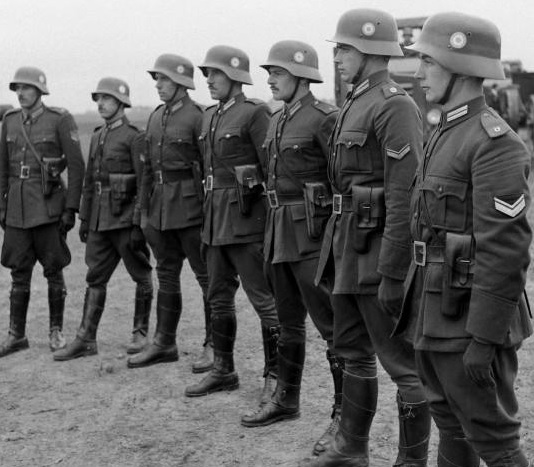
(Argentine soldiers with Casco M38 helmets in the mid-1940s.)
The Casco M38 remained in Argentine use after WWII, albeit slowly declining. In 1946, a new regulation was passed changing the color to earth brown and reducing the size of the roundel, and limiting it to one side. These helmets remained in use alongside increasing numbers of American WWII-surplus M1 pots. In 1949, a large buy of M1s was made and beginning in 1950, these generally replaced all other Argentine military helmet types except the Swiss, which served alongside it until the early 1970s. By the mid-1950s, the Casco M38 was out of service.

(The post-WWII appearance of the Casco M38, with new color and smaller roundel.) (photo from militariarg.com website)
While almost all Argentine stahlhelm photos are of the domestically-made Casco M38, a number of actual German-made steel stahlhelm M35s briefly were in Argentine service. A small quantity (probably no more than 300) of Wehrmancht-issue stahlhelm M35 helmets were supplied with twenty Krupp artillery pieces imported from Germany. These were eventually issued to the Argentine Marine Corps and served until the beginning of the 1950s.
Bolivia
Just prior to WWI, the Bolivian army adopted the German boiled-leather Pickelhaube. In 1921, a small buy of WWI-surplus stahlhelm M18 helmets was imported from Wiemar Germany. These were hated in service as they were too hot in the jungle and too heavy in the mountains. Bolivia was soundly defeated by Paraguay in the 1932-1935 Chaco War and further helmet buys were the least of the country’s worries for that decade.
Early in WWII, Bolivia attempted to stay neutral. The nation is land-locked deep in the South American continent and there was frankly little threat from any side. None the less, the army wanted to gear up and in early 1941, a buy of M1917 helmets was obtained from the USA, which was replacing that type with the M1 pot.
On 7 April 1943, Bolivia joined WWII on the Allied side. Further shipments of M1917s followed from the USA.
In the late 1940s and early 1950s, a significant buy of stahlhelm M35s was made. These were sourced from a variety of origins; wartime captures of the Allies and (after May 1949) from West Germany. The buy from West Germany was done via a convoluted contract as the 1949 re-establishment of German sovereignty included a clause prohibiting the country from financial profit on export of military goods manufactured during the nazi era. As such, they were officially referred to as “Polizei-Policia” on official documents for some time.

Bolivian stahlhelms are painted matte black and feature two side decals, the national shield on the right and unit insignia on the left. The red-yellow-green national shield is extremely similar in shape and layout to the red-white-black shield decal used by the Wehrmacht during WWII.
The stahlhelm M35 was tremendously popular with Bolivian troops, both in function and style. throughout the early Cold War period, it replaced the M1917 and was, until the 1960s, the sole combat helmet in frontline issue. Only in 1964 did Bolivia begin to transition to the American M1 pot helmet.
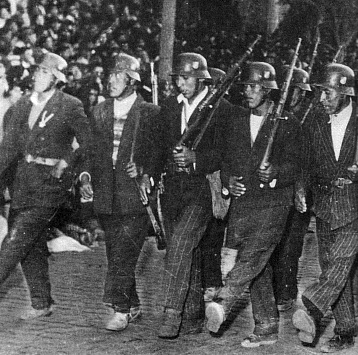
(The armed wing of the conservative National Revolutionary Movement political party in 1952. As Bolivian leftist parties themselves had began to take up weapons, the Bolivian military equipped these men with stahlhelms and vz.24 rifles.)
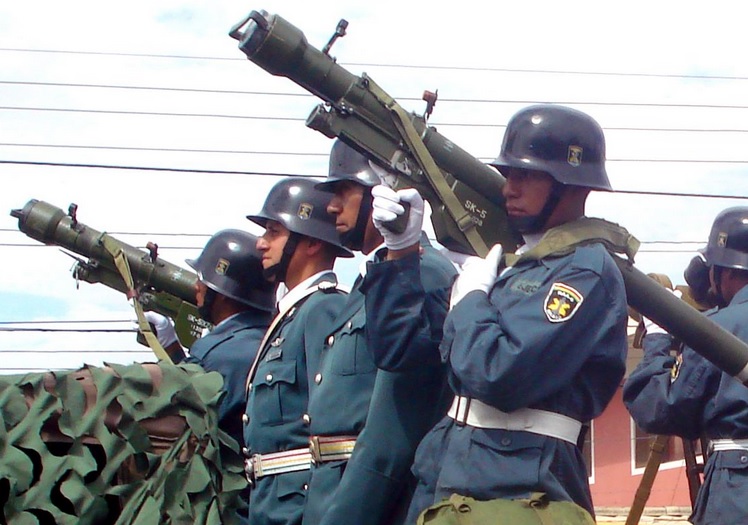
(Bolivian troops with stahlhelm M35 helmets and Chinese-made HN-5 surface-to-air missiles in the early 2000s.)
All of the Bolivian army’s units employed the stahlhelm during the 1950s but in particular it is associated with the 1st Infantry Regiment, the Colorados. This regiment is particularly popular with the Bolivian people. Despite the country’s early history of segregation and discrimination, the all-volunteer Colorados have only ever accepted applicants based on courage and skill, irrespective of racial, economic, or political status.

(The current unit patch of the Colorados is a stahlhelm and crossed bayonets.)
The Colorados regiment has two battalions, the 201st Protocol battalion which fills a similar role to the US Army’s 3rd Infantry “The Old Guard”, and the 202nd which is a special warfare unit. The Colorados regiment also has it’s own training grounds at Quilli Quilli. The 201st Protocol battalion uses the stahlhelm M35 as it’s only helmet, while the 202nd battalion wears them in non-combat settings. Prospective Colorados at the training facility also wear stahlhelms.
The Colorados and the stahlhelm were involved in an odd political incident. The regiment’s motto has always been “¡Viva Bolivia!” (Long live Bolivia!). However in 2010, Bolivia’s left-wing socialist president, Eva Morales, ordered the Colorados to change their motto to Che Guevara’s slogan, “¡Patria o Muerte, Venceremos!” (Nation or death, we’ll win!). This was a slap in the face to the Colorados, who had fought Che and his Bolivian ELN guerrillas in the 1960s. On 22 April 2010, Morales and the visiting Venezuelan dictator Hugo Chavez tried to lead the Colorados 201st battalion in Che’s chant. As an embarrassed Chavez repeatedly shouted the first part, the Colorados in their stahlhelms remained standing at silent attention. After this, the Morales administration tried to save face by saying that the new Colorados motto was only an “alternate”, but in any case it was never used again.
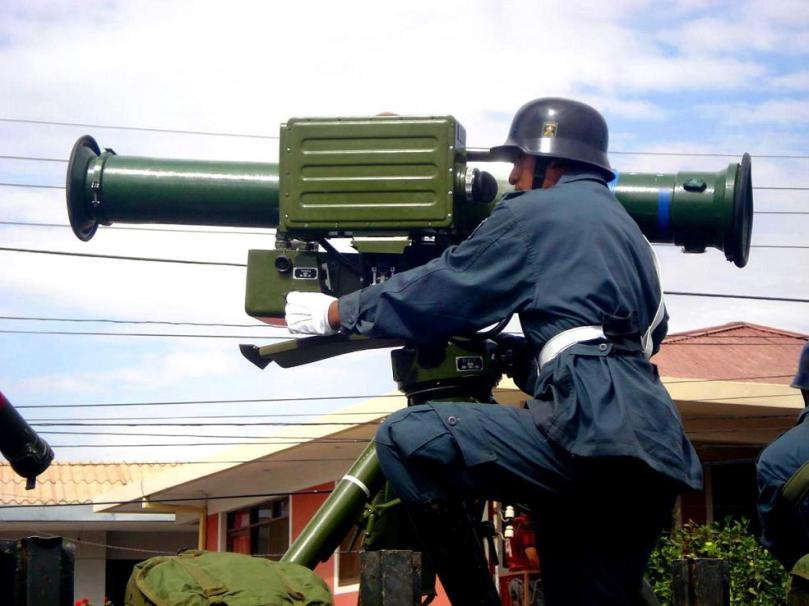
(Bolivian soldier in stahlhelm M35 demonstrating the Chinese-made HJ-8 wire-guided anti-tank missile. This missile replaced Bolivia’s Korean War-surplus M20 Super Bazookas in 2009.)
Besides the Colorados regiment, other infantry and artillery units in the Bolivian military continue to use the stahlhelm M35 for parade and ceremonial use. As of 2016 there is no intention of phasing the German helmets out.
Chile
The Chilean military is the most famous and prolific user of the stahlhelm in South America. In 1937, Chile imported some Wiemar-era Vulkanfiber stahlhelm M33 models, which were already being phased out by the Wehrmacht. These served alongside Czechoslovak-made VZ.32 helmets in the Chilean army; and the German style was preferred.
There were three “runs” of the stahlhelm in Chile. After the positive evaluation of the Vulkanfiber M33 version, a license was taken out to manufacture the steel stahlhelm M35 in Chile. These entered service in the late 1930s.
From 1971-1973, a second production run was made in Chile, to supplement the WWII-era stock which was wearing out. These stahlhelm M35s differ in that they have a revised suspension and chinstrap, and have a corresponding different pattern of bolts. The ventilation holes are omitted.

(The 1970s production run version.)

(Chilean troops in the 1980s, with 1970s-production stahlhelms.)
In the early 1990s, a brief third production run of Chilean M35s was done by FAMAE in Talaganta, Chile. These were basically identical to the 1970s version, however made of a lighter alloy with high-gloss finish as they were intended strictly for ceremonial and parade use. These stahlhelms also have a slightly more pronounced brim edge, to accentuate the helmet’s shape.

(A female member of the Chilean army marching band with a stahlhelm of the 1990s production run.)

(A 3-star Chilean general showing the current full dress flag officer uniform, including stahlhelm, here of the 1990s production run.)
In Chilean service
Chilean troops usually refer to the M35 stahlhelm as “El Gris Verde” (“The Grey Green”) in reference to the color used by Chile. More than anywhere else in the western hemisphere, the stahlhelm is closely identified with the Chilean army, far out of proportion to it’s actual historical use.
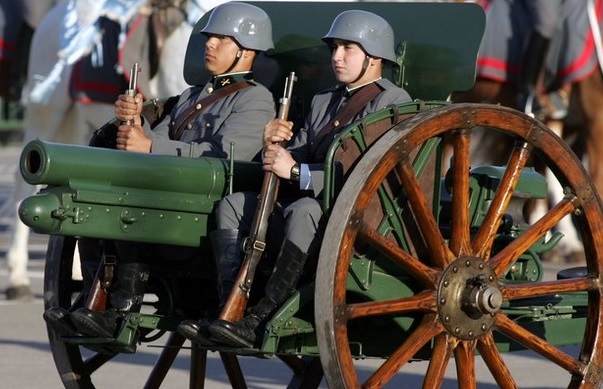
(Gun salute team of the Chilean army with horse-drawn howitzer, Mauser Modelo 1895 rifles, and stahlhelm M35 helmets.) (photo by David Lillo)
In the 1930s, the Chilean military viewed the Third Reich’s Wehrmacht as the ideal force to emulate, and besides helmets, the Chilean army’s uniforms, training, and the such closely followed the Wehrmacht example. For a while, “Prussia’s Glory” was even made the army’s parade song.
On 20 January 1943, Chile broke diplomatic relations with Germany and Japan but did not declare war. On 11 April 1945, Chile declared war on Japan; but not Germany (which surrendered four weeks later anyways). The declaration of war against Japan was primarily to secure automatic Chilean entrance into the new United Nations. Chilean troops took no part in WWII.
Despite the negative worldwide connotation the stahlhelm took on after the defeat of the nazi regime, “El Gris Verde” remained extremely popular with Chilean troops and the population at large. The M35 remained in frontline use after WWII, being the primary battle helmet in the first years after WWII.
After Chile signed the inter-american Rio Treaty in 1947, it gained access to WWII-surplus M1 pot helmets from the USA. Beginning in the late 1940s, Chile imported M1 pots en masse, and decided to make it the force-wide standard battle helmet as quickly as possible. To speed up the transition, M1s were also imported from South Korea, Israel, and Brazil. By the early 1960s the stahlhelm was limited to guard duty or reserve use. By 1970, this process was largely complete and the stahlhelm M35 was reserved for formal parade and ceremonial use only.

At least in the minds of Chileans, the stahlhelm is divorced from any association with nazi-era Germany and is considered as “homegrown” as anything else. As political tides shifted back and forth in the 1940s, 1950s, and 1960s, very little was said about it and the helmet remained popular. When Salvador Allende became the first communist to take power in South America in 1970, he made no move to get rid of the stahlhelm even as he began plans to re-equip the Chilean military with Soviet-bloc arms. Allende’s brief reign ended in 1973 when he was overthrown in a coup. The new leader, Augusto Pinochet, was decidedly-right wing and “El Gris Verde” saw increased exposure in parades and posters, now three decades after WWII. The junta government lasted until 1990 when democracy returned to Chile.

(An infamous photo of Chilean history, Salvador Allende watches Chilean air force planes bomb Santiago at the start of the coup which deposed him. His bodyguards have Soviet-made AK-47s and he is wearing an American-made M1 pot helmet, but faintly visible inside the building is a soldier wearing a stahlhelm.)
The stahlhem achieved some negative publicity when an army band welcomed back the former dictator Pinochet at Santiago airport in 1998. Now for the first time, voices in the Chilean left wing questioned the use of the helmet, given it’s association with both the nazis in Germany and junta in Chile. In 2006, a left-wing socialist president, Michelle Bachlet, was elected and her defense ministry suggested retiring the stahlhelm from parade use. After extended debate, nothing was decided before Bachlet was voted out of office in 2010. In the meantime, actual combat units of the Chilean army were transitioning from the steel M1 pot to the kevlar PASGT helmet, which Chilean troops call “Gulfo” in reference to it’s use by America in Desert Storm. This meant the M35 stahlhelm leapfrogged the M1’s entire Chilean career. In 2016, Bachlet returned to office but the stahlhelm debate had faded and the M35 remains in ceremonial and parade use.

(A Chilean honor guard in stahlhelms welcomes Chairman of the Joint Chiefs of Staff, Admiral Mike Mullen, in March 2009.) (official US Navy photo)
Colombia
Prior to the WWII era, Colombian helmets were a mixed bag. In 1909, the Imperial German boiled leather Pickelhaube was introduced as the country’s first general-issue helmet. In the early 1930s, these were phased out and replaced by license-made copies of the French Mle.15 Adrian, Colombia’s first steel helmet. At the same time, an overseas contact mission of the Wehrmacht suggested German designs. A small number of World War One-surplus stahlhelm M18s were purchased, and license production of the stahlhelm M35 was begun in the late 1930s. The Colombian M35s were actually modeled after the first production run of the Chilean version, based on positive feedback offered by that country’s army to Colombia.
By 1940, the stahlhelm M35 was in general use alongside decreasing numbers of the Adrians. The M18s were generally reserved for second-line use, such as cadets at Colombia’s service academies.
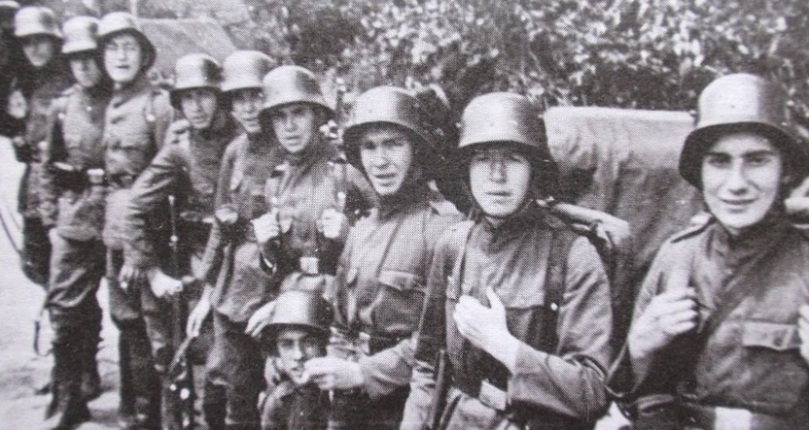
(Colombian army officer cadets during WWII, wearing stahlhelm M18s.)
On 8 December 1941, Colombia broke diplomatic relations with the Japanese Empire but did not declare war. No action of any type was taken towards Germany. Colombia was desperately trying to stay out of WWII. After a series of ill-advised comments by nazi officials in Berlin, Colombia broke diplomatic relations with Italy and Germany as well eleven days later. Throughout 1942 and 1943, Colombian-flagged merchantmen were repeatedly attacked by German u-boats and on 26 November 1943, the country finally entered WWII.
During the final two years of WWII, small numbers of M1 pot helmets began to arrive as Lend-Lease aid from the USA. Meanwhile the stahlhelms remained in use during the war, and after.
From 1948-1953, Colombia endured what was simply called “La Violencia” (the violence) a very turbulent period of political instability, insurrection, and street violence. The army was called upon both to fight insurgencies in the jungle and to curb violence in the cities. During this period, the stahlhelm M35 remained in use alongside growing numbers of WWII-surplus M1 pot helmets from the USA.

(Colombian troops on the streets of Bogota in the 1948-1949 time frame.)
In the early Cold War era, the USA identified Colombia as a key ally. Other than Panama itself, Colombia was the nearest country to the then-Panama Canal Zone. As such, in 1949 a huge allotment of WWII-surplus M1 pots was transferred by the USA at rock-bottom prices. The transition to this helmet was thus very rapid and by 1951 the M1 was the lone helmet in use.
A small number of the stahlhelm M35, stahlhelm M18, and even some Pickelhaube helmets were retained by the Colombian army. A tradition of the force on national holidays is “los desfiles”, when units parade in successive historical eras of uniforms and rifles. The German helmet types are still displayed in this way today.

(The stahlhelm representing the 1940s during a 2004 los desfiles display in Bogota.) (photo via JAOR)
Dominican Republic
The Dominican Republic’s use of the stahlhelm is unique in that the country never had even evaluated any other German helmet type, before, during, or after WWII. During the war, the Dominican Republic’s army (which was at the time, fairly advanced and disproportionately powerful in relation to the country’s size) received huge shipments of surplus M1917 helmets from the USA, which had replaced that type with the M1 pot. As WWII continued, more M1917s and some M1s were supplied under Lend-Lease.
The Dominican Republic was led by strongman Rafael Trujillo from 1931-1961. The USA’s attitude towards Trujillo waxed and waned over the decades. Periodically, the USA would embargo weapons to the country. In the mid-1950s, during one such embargo, Trujillo decided he wanted to modernize his military’s appearance including replacing the pre-WWII M1917 helmets, some of which embarrassingly remained in use. Trujillo’s political stance ruled out any helmet of Soviet origin, and since pretty much most of the free world was using American-supplied M1 pot at that time, the options were limited.
A solution was found in the stahlhelm used by the Bundesgrenzchutz (Federal Border Police) of West Germany. Formed when West German sovereignty was re-established in 1949, the Bundesgrenzchutz patrolled the inter-German border which was literally the crease of the Cold War, where a Warsaw Pact attack might come at any moment. As such, it had a decidedly para-military character in weapons and uniforms. For reasons both financial and political, the Bundesgrenzchutz was initially equipped with WWII stahlhelms donated back by the western Allies. These were a mixture of the standard stahlhelm M35, and it’s wartime M40 and M42 versions. These were cleaned, stripped of any Wehrmacht or Waffen-SS markings, repainted, and reissued. This saved scarce money for the Bundesgrenzchutz and also differentiated it from the Bundeswehr, which used the M1 pot.
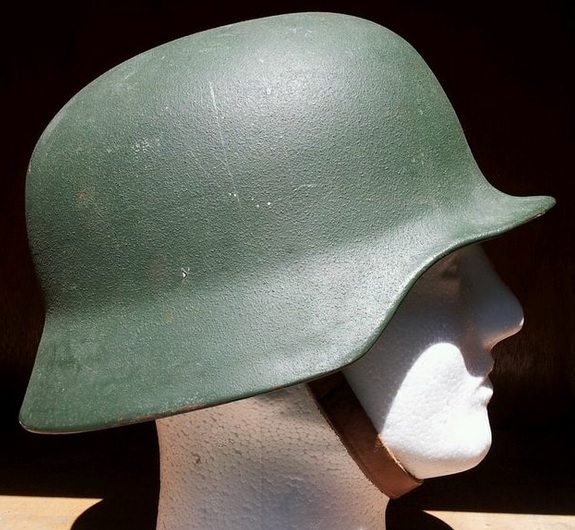
(The stahlhelm M53, also called M35/53, is the ‘smoothest’ version in appearance with no vents or bolts.)
By the 1950s, these helmets were wearing out. A new production run was ordered. Designated stahlhelm M53, or sometimes M35/53, these are regarded as the final true members of the stahlhelm family. The stahlhelm M53 was generally identical in shape to the wartime M40 version of the M35, however the ventilation holes were omitted. The leather suspension was a sort of hybrid between the stahlhelm M35 and that used on the M1 pot. These stahlhelm M53s remained in West German Bundesgrenzchutz use until the two Germanys reunited in 1990.
In the Dominican Republic, the stahlhelm M53 was viewed as an ideal choice as it bypassed the American embargo, and was obviously a proven successful helmet design. Additionally in any future war against arch-rival Haiti, it would be differentiated on the battlefield from that country’s army which exclusively used M1 pots.
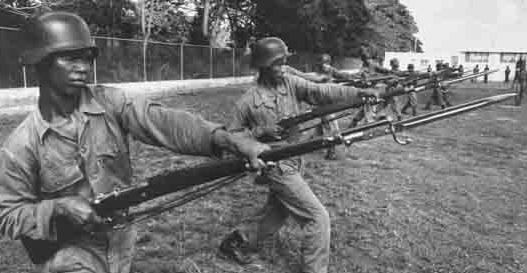
(Dominican Republic soldiers wearing the stahlhelm M53. Their rifles are the M1953, which were Brazilian Mauser 1908s bought as surplus after WWII and reconditioned by San Cristobal Arsenal.) (photo via Shotgun News magazine)
Several thousand were imported during the mid-1950s. All of the Dominican Republic’s stahlhelm M53s were manufactured by Linnemann-Schneztler in West Germany. As delivered, they were painted matte blackish-brown. Some diverted to the Dominican Republic navy were repainted sea blue, while a few that went to the country’s air force had large pilot wings painted on them.
Almost all went to the army, and the quantity delivered was not sufficient to re-equip all divisions. The Guardia Presedencial was the first unit to convert to the stahlhelm, followed by select infantry battalions. The helmet was well-liked by Dominican Republic soldiers.
After Trujillo’s assassination in 1961, military aid was re-established by the USA and cheap supplies of M1 pot helmets ended the stahlhelm project. The stahlhelm M53s were viewed somewhat as a reminder of the Trujillo regime, and their public use after 1961 was muted.

On 30 April 1965, the United States invaded the Dominican Republic (operation “Power Pack”) and briefly occupied the country. When the Dominican Republic army was reformed with American help, it fully standardized on the M1 pot which was it’s exclusive helmet until the turn of the millennium. The stahlhelm M53s were mostly melted as scrap and today, ex-Dominican Republic stahlhelms are extremely rare for collectors.
Uruguay
When the Casco M38 was phased out of Argentine service, some were offered as aid to Uraguay in the 1950s. Found unsuitable for military use, they were instead used by wardens of the national prison system for several years.

(Casco M38 of the 1950s Uruguayan wardens service. The national emblem was added after they were imported from Argentina.)

[…] Source: The stahlhelm in Latin America after WWII […]
LikeLike
Hello,Could i translated your essay into chinese language?
LikeLike
yes, that is good!
LikeLike
It’s certainly a well used and well designed helmet that gave good protection to its wearer. Widely copied it remains synonymous of nazi Germany regardless of how it has been altered. A really interesting post that’s opened my eyes to it. Thank you.
LikeLiked by 1 person
Thanks for an excellent article. One small point: the photo entitled “Argentine soldiers with Casco M38 helmets in the mid-1940s” is the wrong way round.
LikeLike
ustedes yankis imperialistas no saben nada
LikeLike
Sorry Pedro, unfortunately I am limited to English, Deutsche, and a little Srpski.
LikeLike
Pedro said: “You imperialist Yankees know nothing”. I’m not sure who he was directing his comment at, but I for one am not an American.
LikeLike
LOL I don’t get why he is angry. Is something in the article inaccurate?
LikeLike
Thanks for this excellent article
LikeLiked by 1 person
Hello I really enjoyed your article, Iam Colombian and come form a Colombian Military Family and I have some pictures of Colombian stahlhelms if you want to see them
LikeLiked by 1 person
yes please feel free to share if you wish
LikeLike
Also don’t forget the Philippines Army continues to use the German Stahlhelm at present in 2017 – I just saw yesterday a TV news item showing troops in the Mindanao conflict wearing them! Also Philippines is the only country in the world where Rommel is a popular male first name (so is Erwin, by the way) But that has nothing to do with Nazism, it appears they just like the name and many don’t even realize he was a German WW II general!
LikeLiked by 1 person
Chile had influence of German generals before the first World War
https://es.wikipedia.org/wiki/Emilio_K%C3%B6rner
Even the Chilean Navy has some rather Prussian influences … although it has a greater English influence
LikeLiked by 1 person
The picture that begins with “A 3-star Chilean general” actually shows a Colonel of the Chilean Army, not a general.
LikeLike
En realidad es un Capitán, ya que la presilla de Coronel es trenzada,…. y un general las hombreras son perpendiculares
LikeLike
Sorry, my mistake. It is really a Captain, I forgot that a Colonel has 3 stars and a bar under them in the helmet.
LikeLike
I would like to point out that the Chilean Army organisation was Prussian, not Wehrmacht, in origin. That is where the Germanisation occurred.
LikeLiked by 1 person
There are images of Cuban Soldiers and Guatemalan Police using the Stahlhelm as well.
LikeLiked by 1 person